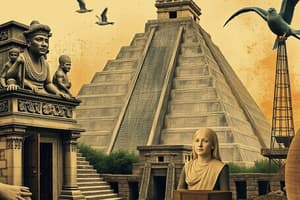Podcast
Questions and Answers
¿Qué tipo de animales criaban principalmente las personas incas?
¿Qué tipo de animales criaban principalmente las personas incas?
Alpacas, llamas y cuyes
¿Cuál fue el material principal utilizado para construir las casas en la sociedad inca?
¿Cuál fue el material principal utilizado para construir las casas en la sociedad inca?
Piedra o barro de adobe
¿En qué valle se establecieron los primeros incas alrededor del año 1100?
¿En qué valle se establecieron los primeros incas alrededor del año 1100?
Valle de Cusco
¿Quién fue el noveno emperador inca que expandió enormemente el territorio incaico en 1438?
¿Quién fue el noveno emperador inca que expandió enormemente el territorio incaico en 1438?
¿Qué idioma se utilizaba como lengua oficial en el Imperio Inca y a quiénes se les daban trabajos gubernamentales?
¿Qué idioma se utilizaba como lengua oficial en el Imperio Inca y a quiénes se les daban trabajos gubernamentales?
¿Quién era el dios principal en la religión inca?
¿Quién era el dios principal en la religión inca?
¿Qué elementos combinaba la religión inca?
¿Qué elementos combinaba la religión inca?
¿Qué edificio inca en Cusco estaba revestido con 700 láminas de oro y decorado con esmeraldas?
¿Qué edificio inca en Cusco estaba revestido con 700 láminas de oro y decorado con esmeraldas?
¿Qué sistema utilizaban los incas para registrar información?
¿Qué sistema utilizaban los incas para registrar información?
¿Qué red construyeron los incas para facilitar el comercio y la comunicación?
¿Qué red construyeron los incas para facilitar el comercio y la comunicación?
Flashcards are hidden until you start studying
Study Notes
Inca Civilization
The Inca civilization, also known as the Inca Empire, was a highly advanced civilization that ruled a significant portion of South America from the 13th to the 16th century. Spanning from modern-day Colombia to Chile, the Inca Empire was the largest in the Americas and the largest in the world at the time. Despite being conquered by the Spanish in 1533, the legacy of the Inca civilization continues to influence the culture and traditions of the people in the Andes region, particularly the Quechua-speaking population of Peru.
Inca Society
Inca society was highly stratified, with the emperor ruling with the aid of an aristocratic bureaucracy. The Inca people were primarily farmers or herders, focusing on raising animals like alpacas, llamas, and guinea pigs, and cultivating crops such as corn, potatoes, and beans. Inca society was based on extended families who lived together on the same land, producing their own clothing and blankets from alpaca and llama wool. Houses were made of stone or adobe mud, topped with a roof of dried grass.
Inca Empire
The Inca Empire began around 1100 when the Inca people settled in the valley of Cusco. In 1438, Pachacuti Inca Yupanqui became the ninth Inca emperor and embarked on a massive expansion of the Inca territory, conquering neighboring people and giving government jobs to those who spoke Quechua, the Inca language. At its peak, the Inca Empire ruled over approximately 12 million people who spoke about 30 different languages.
Inca Religion
The Inca religion combined elements of animism, fetishism, and the worship of nature gods. The pantheon was headed by Inti, the sun god, and included other deities such as Viracocha, a creator god, and Apu Illapu, the rain god. Under the Inca Empire, the religion was a highly organized state religion, but native religions were also tolerated.
Inca Architecture
Inca architecture was highly developed, with impressive buildings like the Temple of the Sun in Cusco, which was lined with 700 sheets of beaten gold and studded with emeralds. The Inca also constructed vast plazas, parklands, shrines, fountains, and canals, many of which still exist today.
Inca Technology
Inca technology was advanced for its time, with the development of irrigation systems, palaces, temples, and fortifications. The Inca also built a vast network of roads throughout their empire, which facilitated trade and communication. They used a system of knotted cords called quipus to record information.
In conclusion, the Inca civilization was a remarkable and influential society that left a lasting impact on the people and land of the Andes region. Despite the passing of time and the challenges faced by the Inca people, their legacy continues to be felt in the culture and traditions of the Quechua-speaking population of Peru and beyond.
Studying That Suits You
Use AI to generate personalized quizzes and flashcards to suit your learning preferences.




